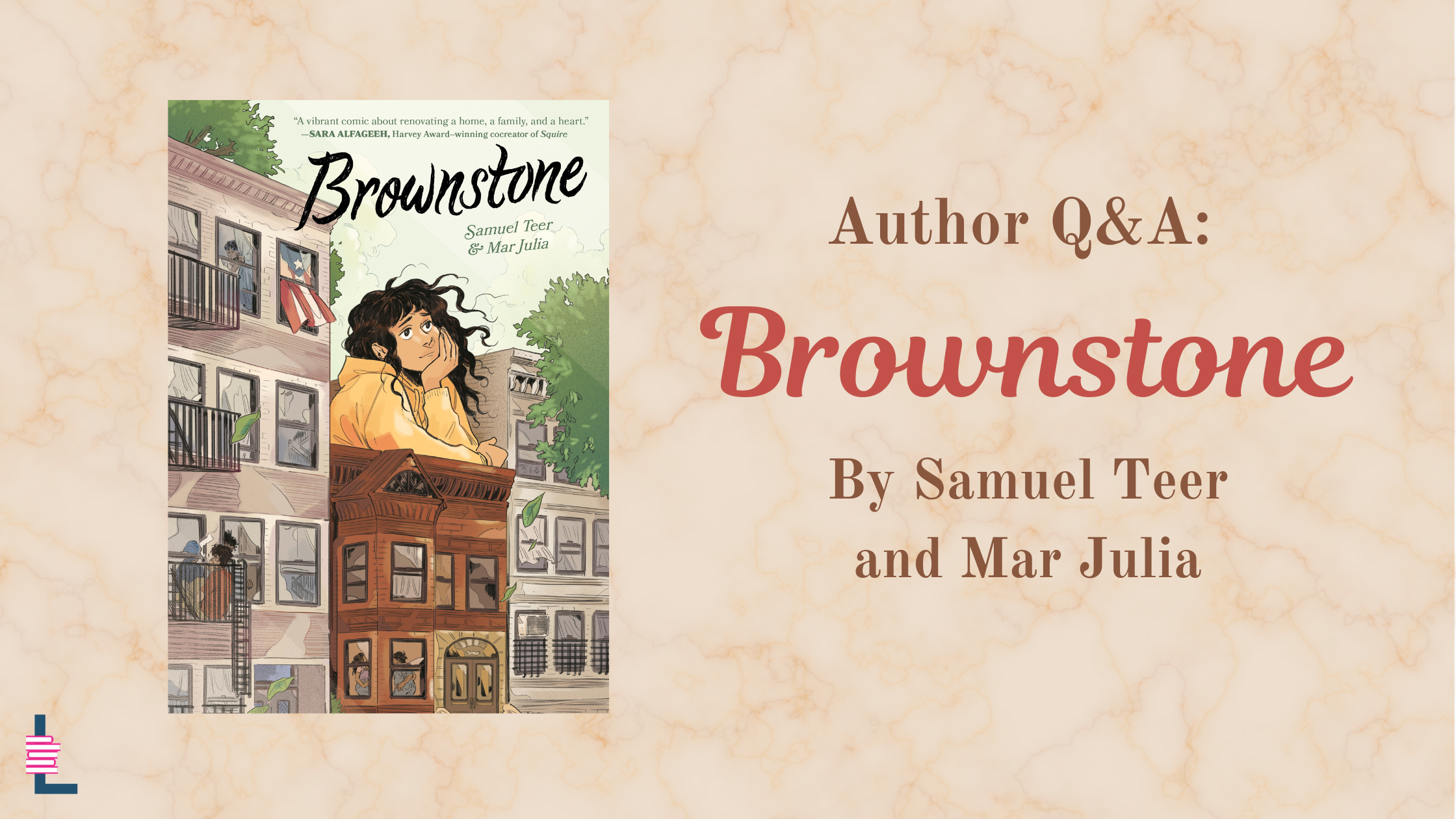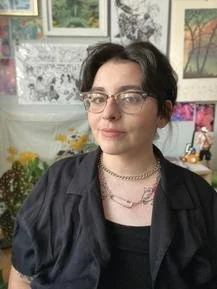Brownstone by Samuel Teer and Mar Julia begins with both dread and anticipation. Almudena’s mom is looking forward to her once-in-a-lifetime trip to be in an international touring dance production.
But Almudena? Well, the 14-year-old is on her way to spend the entire summer with her father. Thoughts swirl in her head: “Am I okay with having to stay with a father that I’ve never met and know nothing about for three goddamn months? NO!”
When mother and daughter arrive at their destination, Almudena comes face-to-face with Xavier, who is from Guatemala. Almost immediately there is a language barrier between them. Almudena’s mom is white and, though she speaks some Spanish, they don’t speak the language at home.
Before them is a broken-down brownstone, and Xavier brings Almudena inside. He expects her to live in and help fix it up during their time together. So begins a summer of transformation for Almudena, who struggles with her identity all while forging new friendships in this new environment.
Winner of the 2025 Michael L. Printz Award, Brownstone (from Versify) is a moving and often hilarious YA coming-of-age graphic novel that touches on themes of identity, culture, and finding one’s place in a community. Readers will feel as though they’re also living in the worn-down brownstone with Almudena as she navigates new territory, and as she and her father figure out how to become family.
Teer spoke with Latinx in Publishing about the inspiration behind Brownstone, identity, language, and more.
This interview has been edited for clarity and brevity.
Amaris Castillo: Congratulations on Brownstone, which I understand is the result of years of work by yourself and Mar Julia. What inspired this story?
Samuel Teer (ST): I was working at a hardware store part-time, trying to do comics. I was stocking shelves and happened to be walking by a 14 or 15-year-old Latina girl translating between one of the Caucasian employees and her dad. A thought occurred to me: I wonder what their story is. There was something about that scene that made me want to know more. I kept percolating in the back of my head for the rest of the day. And I was like, Oh, I wonder if their story is similar to my story, and Mar’s story. I started using that visual as a springboard to go, Oh, well you can sort of graft the never really fitting in with your family and sort of being literally in between two worlds. You can sort of graft that onto this imagery. And then Brownstone started to take shape. The more Mar and I talked, we discovered that we had a lot of similarities growing up, despite growing up in vastly different environments.
AC: Your main character, Almudena, is being sent to spend the summer with her Guatemalan father, who she’s never met. Her mom, who is white, has a unique once-in-a-lifetime opportunity to perform with a touring dance group. Now Almudena is thrust into a very different, Latino neighborhood, and tasked with helping her father with the renovation of an old brownstone. There’s so much she’s being introduced to, but I’m curious about how you came up with the brownstone renovation plot point?
ST: My wife and I had bought a house right before the active writing of Brownstone, so we were fixing the house that we paid for. As we’re doing that, the way my brain tends to work is that everything is like, Oh, maybe this is something to file away later that can work in a comic. So as that’s getting done, you see the day-to-day progression. That was an interesting visual metaphor for them building a relationship.
The other portion is, I went to Guatemala for the first time when I was 15. I met my maternal great-grandfather. He lived in a building very similar to the brownstone. So it was about linking those two things from my past with my present at the time, and being like, This building represents something. This tall rectangle represents something for me. I thought having that be a centerpiece made sense to build the story around.
“Which is, truthfully, what comics is: You are looking at what other people have done, and you’re building upon it. Which is also a metaphor for the book. It’s about building.”
AC: This story is very much about a father and daughter trying to wade through language barriers, as well as cultural barriers because Almudena is just now learning about her Guatemalan heritage. Can you walk us through what it was like to piece together the dynamics of their relationship?
ST: With Xavier and Almudena specifically, I knew there needed to be a push-pull. They had a lot of similarities and a lot of fears. Writing Almudena was very easy for me. I am a little bit stunted still, and so writing kind of a bratty 14, 15-year-old comes pretty naturally to me. That was very much a part of the fabric of my soul; like, I don’t get this. This doesn’t make sense. Why is the world not conforming to what I need it to be? Why don’t I fit in?
Looking at it from Xavier’s perspective, he’s also very alienated. Even though he’s in a community, he’s still an outsider. There’s a chapter late in the book where Xavier writes a letter to Almudena that is him telling her where he’s been her entire life, and why he wasn’t around. For me, at the time of writing that, we were foster parents. We had a 17-year-old Latina in our house, and that was just me writing to her and telling her, I am so scared about this. You want to run away, and you don’t. Knowing those two bits, that Almudena was going to be kind of a brat, but eventually even out a little bit towards the end, and that Xavier was going to be an intensely lonely person surrounded by people, I knew that they would be able to connect. Those two are obviously core to the story, but the story is very much about their relationship.
AC: There are many themes in your book – most prominent among them is what it’s like to grow up mixed-race which I imagine you took from your lived experience as well. I thought it was interesting how, at times, Almudena hears conversations by her father or other characters as “really fast Spanish-sounding stuff.” It made me chuckle at times. How did you arrive at describing Spanish in this way?
ST: Mar is better at speaking Spanish now than I am. Mar and I both understand Spanish when our families talk to us, but we have a hard time speaking it. You’re processing it. You’re like, I know this is Spanish. I can hear the tone change, so I’m definitely in trouble at this moment. That kind of thing. We wanted to try to get that experience, that sort of texture, into the story. I honestly lifted the very basic idea of the little brackets saying, ‘It’s this language’ from Matt Fraction when he did his run on Marvel’s Hawkeye (series). I think it’s in the first couple of issues, but there’s some Tracksuit Mafia guys. It’s sort of like, ‘Vaguely European cursing’ or something like that in Fraction’s book. And I was like, Oh, that’s a wonderful way of taking that and making it fit this book. Which is, truthfully, what comics is: You are looking at what other people have done, and you’re building upon it. Which is also a metaphor for the book. It’s about building.
AC: As a teen whose parents are not together, Almudena has always had this image in her head of a family, and what it should look like. I thought you and Mar Julia displayed this really effectively, because it’s something that I am sure many kids whose parents aren’t together. What message were you hoping to send by having Almudena have this vision?
ST: I wanted to track her actual character growth. That she’s gonna have these flights of fancy, and have a very vivid imagination of: This is what my dad could look like, or this is what it could look like if my parents get back together, and it’ll be perfect. And for her to be the one, to be like, Hey, maybe this doesn’t have to be perfect. Maybe this doesn’t have to be the way that it is in my head. It can just be what it is. She has her quinceañera, but to me that’s the moment that she starts to become an adult. It’s that moment of, Oh, maybe this doesn’t have to be this very child-like dream.
AC: What was it like working with Mar? I understand you approached Mar early in the process of making Brownstone, so you worked on this together from the ground up.
ST: Yeah, that’s pretty much what we did. I wanted to work with Mar on something. Mar wanted to work with me on something. I came home that day from the hardware store and pitched this idea via email. And Mar was like, “Yeah, that sounds great.” And I was like, “OK, cool. Oh crap, I have to figure out how to write this.” But Mar’s art was just something I was in love with from moment one, well before Brownstone. So far I’ve only worked with people who are my dream artists to work with, and that is such a lovely thing.
You have some imagery in your head as you’re writing. The best thing about Mar’s artwork is that Mar always brings something that’s so much better than what’s in my head, and it immediately supplants what’s in my head. We had sketches and character designs as I was writing. And, you know, in my head, I’m envisioning realer people. And the second I see that, I’m like, OK, these are the characters now... And I just so adore everything that Mar brought to the table.
AC: What do you hope readers take away from Brownstone?
ST: This is a complicated question. Honestly, I hope they take away whatever they take away from the book. I have had people approach me and say, Oh, I got this from the book. And I’m like, Oh, I didn’t expect that. So that’s always very nice. I would definitely encourage them to just get out of it whatever you get out of it. If there’s maybe a thematic intent that I hoped for, it’s that you don’t have to fit into a binary about what it means to what is or isn’t Latinx enough.
Mar Julia lives on an unceded Piscataway land that makes up Baltimore, Maryland. Previous comics credits include the ‘Lumberjanes’ and ‘Adventure Time' series. Brownstone is their debut full-length graphic novel.
Samuel Teer is the author of Brownstone and Veda: Assembly Required. Raised outside of St. Louis, Missouri, he lives in Aurora, Colorado.
Amaris Castillo is an award-winning journalist, writer, and the creator of Bodega Stories, a series featuring real stories from the corner store. Her writing has appeared in La Galería Magazine, Aster(ix) Journal, Spanglish Voces, PALABRITAS, Dominican Moms Be Like… (part of the Dominican Writers Association’s #DWACuenticos chapbook series), and most recently Quislaona: A Dominican Fantasy Anthology and Sana, Sana: Latinx Pain and Radical Visions for Healing and Justice. Her short story, “El Don,” was a prize finalist for the 2022 Elizabeth Nunez Caribbean-American Writers’ Prize by the Brooklyn Caribbean Literary Festival. She is a proud member of Latinx in Publishing’s Writers Mentorship Class of 2023 and lives in Florida with her family.










